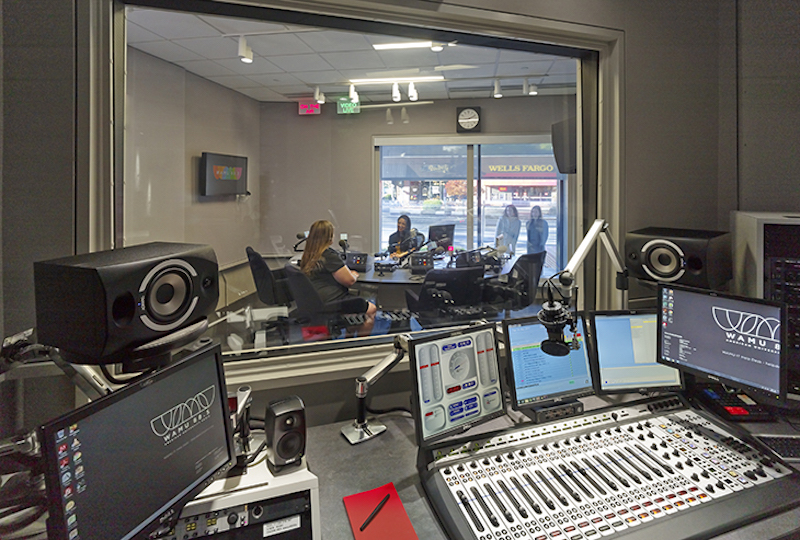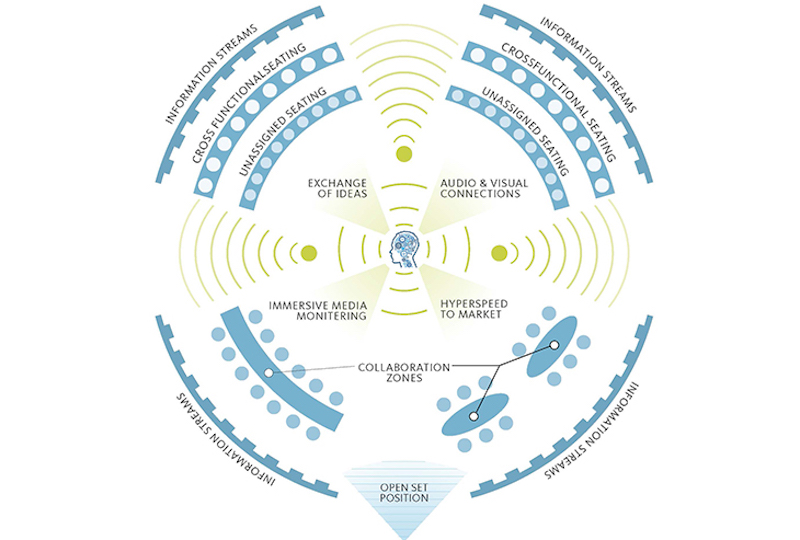Although the term newsroom is still embraced by the media industry, it’s slowly being replaced by the converged environment, and the shift is as much about space as it is about linguistics.
As a realm that shapes activity, the converged environment—a byproduct of the media convergence phenomenon—is a charged, open, and integrated space that enables workflows tailored to today’s media drivers: mobile platforms, social media, video, niche fan bases in lieu of mass audiences, data as a driver of decision making, Twitter as a vehicle for breaking news, and apps as a source of specialized content. In essence, the converged environment is a live-streaming workplace, a zone where news and content flow continuously and speed to market is everything.
Because the forces shaping the converged environment have become drivers within the span of just a few years, the standard news media environment (and, by extension, the standard news media operational model) has struggled to respond accordingly. Only recently have we seen spatial responses tailored to support the workflows inherent to a converged environment.
Given the ongoing need to create a consensus on what a truly converged environment consists of, we’ve assembled a set of essential design considerations based our experience developing such spaces. And because of the blurring of the lines between various forms of media and technology, these considerations are applicable across a wide spectrum of the industry:
Rise of the Nerve Center
Breaking news now unfolds live, 140 characters at a time. Thus, building on breaking stories calls for Mach-speed editorial decisions. Such conditions necessitate an operational center for decision making and the universal distribution of content across multiple platforms. For our soon-to-be-completed design of the Washington, D.C., outpost of Thomson Reuters, we’ve created just such an operational center. Reuters’ redesigned space will revolve around a hub of workstations and a ribbon of monitors that display the latest news and information from across a variety of platforms, resulting in a true transmedia workplace.
Unassigned Seating
Mobility and fluid teaming are keys to creating and disseminating content in today’s world of rapid-fire news. So think scrums and cross-collaboration, not assembly line production. Unassigned seating also opens up interactions across the organization, enabling greater innovation regarding content production and dissemination.
Cross-functional Teaming
Creating a frictionless and speedy production process means enabling multi-disciplinary teaming. Reporters, engineers, social media specialists, videographers and a host of other professionals need to intermingle to allow content to go from idea to implementation in minutes.
Active and Well-being Focused
The speed, pressure, and intensity of the media industry need to be balanced with workplace elements that energize, inspire and calm. From sit–to-stand desks to spaces that maximize daylight to design that better integrates nature, a media environment that takes wellness into account will not only be a healthier and more inspiring place to work, but also a more productive place.
Blurring Lines from On-Air and Off
The integration of casual, flexible, and quick broadcast options make video production that much easier. For The Washington Post, we designed a formal video studio, much like what you’d find in a traditional broadcast news environment. But we complemented that space with three informal live-shot settings spread across the media giant’s space to enable them to push out video at a moment’s notice. Similarly, our design of Washington, D.C.’s WAMU radio station features single-operator booths that allow talent to easily conduct interviews and quickly disseminate content over the airwaves or online.
 WAMU 88.5 Operator Booth. Image © Alan Karchmer
WAMU 88.5 Operator Booth. Image © Alan Karchmer
Start-up Incubator Mentality
News organizations are increasingly embracing a tech start-up mentality in terms of the kinds of workflows they’re adopting and the kinds of workers they’re hiring. That’s why developers are becoming an increasingly important commodity in media environments. Instead of having a siloed and dedicated department for those with jobs that slant more toward tech than storytelling, news organizations should enable these specialists to disperse throughout the converged environment for more integrated content creation and distribution.
Agile and Flexible Workplace and Technology
Rapidly evolving technology is a fact of life. And for an industry as tech-dependent as media, it’s key that workplaces can accommodate whatever technology comes over the horizon; no one wants to revamp a space every few years because technology keeps rendering it obsolete. To that end, adjustable workstations that can be reconfigured easily or moved, along with power outlets and AV that are equally mobile, enable news organizations to reshape their spaces as needed. And universal design—i.e., one-size-fits-all workstations and offices—can imbue a space with interchangeability and additional flexibility.
News Environment as Brand Touchstone
A media space should also function as an engaging brand experience for all. To create such an experience for The Washington Post, we dug into the media entity’s archives to incorporate elements of its legacy in surprising ways: Tone-on-tone images of famous Post front pages line a feature wall. Collections of the paper’s historic headlines adorn conference room glass fronts. Signage from the paper’s former building greets guests in the reception area. And the paper’s iconic nameplate, rendered as a three-dimensional graphic element, functions as both an on-camera background element and well-integrated off-camera branding component.
Open and Collaborative
Digital is inherently open and collaborative, and converged environments need to reflect that reality. To enable the fast, collaborative communication needed to efficiently push out information 24/7a cross digital and other platforms, media organizations need open, non-hierarchical, interchangeable space. However, because focus work is also part of the equation, openness must be balanced with proper acoustical considerations. Sound-deadening solutions on ceilings, walls and workstations can help absorb excess noise and maintain an acoustical environment that’s suitable for multiple work modes. To that end, the converged environment must also feature dedicated spaces for intense focus work or private calls.
 Key elements in a converged environment.
Key elements in a converged environment.
The idea that unites all of the above elements is adaptability. Ultimately, the converged environment is a space that opens up possibilities. It is not a space that creates hard borders, clear definitions or limited functionality. Because of its fungible nature, the converged environment is a space ready-made to adjust to the next set of disruptive forces: 5G mobile speeds, virtual reality and augmented reality. Thus, the seeds of tomorrow’s converged environments are contained in today’s media spaces.
More from Author
Gensler | Apr 15, 2024
3 ways the most innovative companies work differently
Gensler’s pre-pandemic workplace research reinforced that great workplace design drives creativity and innovation. Using six performance indicators, we're able to view workers’ perceptions of the quality of innovation, creativity, and leadership in an employee’s organization.
Gensler | Mar 13, 2024
Trends to watch shaping the future of ESG
Gensler’s Climate Action & Sustainability Services Leaders Anthony Brower, Juliette Morgan, and Kirsten Ritchie discuss trends shaping the future of environmental, social, and governance (ESG).
Gensler | Feb 15, 2024
5 things developers should know about mass timber
Gensler's Erik Barth, architect and regional design resilience leader, shares considerations for developers when looking at mass timber solutions.
Gensler | Jan 15, 2024
How to keep airports functional during construction
Gensler's aviation experts share new ideas about how to make the airport construction process better moving forward.
Gensler | Dec 18, 2023
The impacts of affordability, remote work, and personal safety on urban life
Data from Gensler's City Pulse Survey shows that although people are satisfied with their city's experience, it may not be enough.
Gensler | Nov 16, 2023
How inclusive design supports resilience and climate preparedness
Gail Napell, AIA, LEED AP BD+C, shares five tips and examples of inclusive design across a variety of building sectors.
Gensler | Oct 16, 2023
The impact of office-to-residential conversion on downtown areas
Gensler's Duanne Render looks at the incentives that could bring more office-to-residential conversions to life.
Gensler | Sep 13, 2023
Houston's first innovation district is established using adaptive reuse
Gensler's Vince Flickinger shares the firm's adaptive reuse of a Houston, Texas, department store-turned innovation hub.
Gensler | Aug 7, 2023
Building a better academic workplace
Gensler's David Craig and Melany Park show how agile, efficient workplaces bring university faculty and staff closer together while supporting individual needs.
Gensler | Jun 29, 2023
5 ways to rethink the future of multifamily development and design
The Gensler Research Institute’s investigation into the residential experience indicates a need for fresh perspectives on residential design and development, challenging norms, and raising the bar.
















